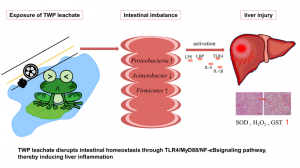Tire-Wear Particles Pose Health Risks to Aquatic Organisms
GA, UNITED STATES, October 25, 2024 /EINPresswire.com/ -- A recent study highlights the hepatotoxicity of tire-wear particle (TWP) leachates in aquatic environments, impacting gut-liver axis and inducing oxidative damage. The findings suggest potential health risks for aquatic organisms.
In a study published in Environmental Chemistry and Ecotoxicology, researchers from Hangzhou Normal University uncovered the adverse health effects of tire-wear particles (TWPs) on aquatic organisms. The study, led by Zhiquan Liu, focused on the hepatotoxicity of TWP leachates, revealing significant impacts on the gut-liver axis and oxidative stress levels in test organisms.
“TWPs, primarily produced through tire-road friction, are released into the environment in vast quantities,” says Liu. “Each year, approximately 6.1 million tons of TWPs are estimated to enter aquatic ecosystems, posing a significant threat to biodiversity.”
This prompted the researchers to investigate the effects of TWP leachates on black-spotted frogs (Pelophylax nigromaculatus), a highly susceptible amphibian species.
“We found that TWP leachates induced hepatic oxidative stress, inflammation and histopathology changes in the frogs. Specifically, increased levels of reactive oxygen species (ROS) and activation of signaling pathways closely related to immunity were observed,” shares Liu.
These changes were accompanied by disruptions in the gut microbiota, with a notable increase in Proteobacteria, a major source of gut-derived endotoxic lipopolysaccharide (LPS). Such disruptions in the gut-liver axis and oxidative stress levels can lead to long-term health issues for affected organisms.
The team also found that zinc, a trace metal commonly found in TWP leachates, accumulated in the intestine, liver and kidney of the test frogs, further confirming the absorption and bioaccumulation of TWP leachates by aquatic organisms.
DOI
10.1016/j.enceco.2024.08.004
Original Source URL
https://doi.org/10.1016/j.enceco.2024.08.004
Funding information
This study was funded by the State Environmental Protection Key Laboratory of Environmental Health Impact Assessment of Emerging Contaminants (SEPKL-EHIAEC-202201), Natural Science Foundation of Zhejiang Province of China (LQ22C030003), the National Natural Science Foundation of China (42207323), “Pioneer” and “Leading Goose” R and D Program of Zhejiang (2023C03130).
Lucy Wang
BioDesign Research
email us here
Legal Disclaimer:
EIN Presswire provides this news content "as is" without warranty of any kind. We do not accept any responsibility or liability for the accuracy, content, images, videos, licenses, completeness, legality, or reliability of the information contained in this article. If you have any complaints or copyright issues related to this article, kindly contact the author above.

